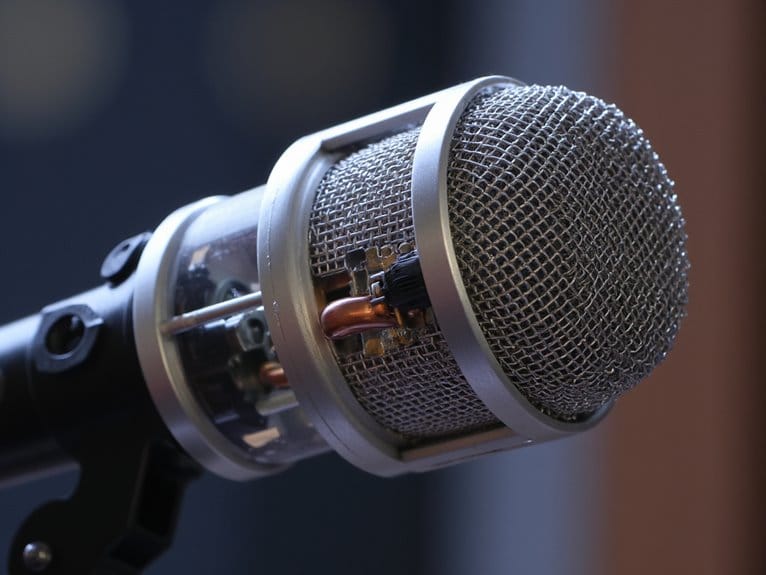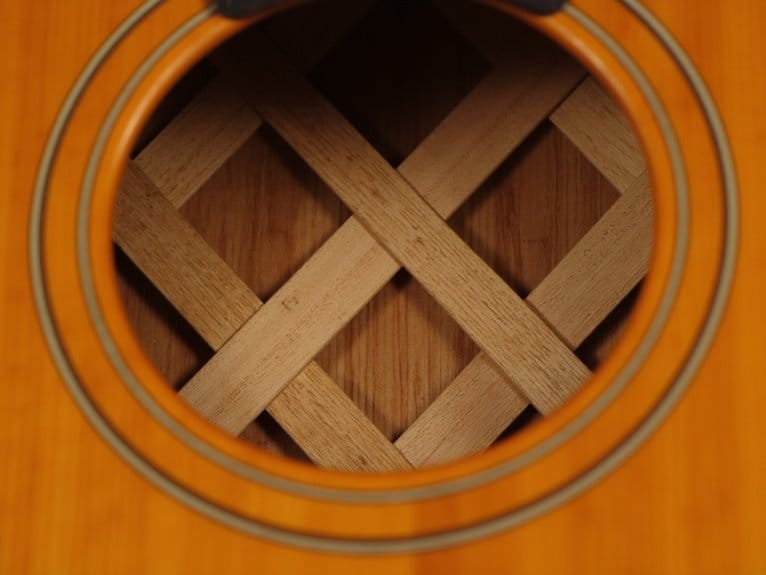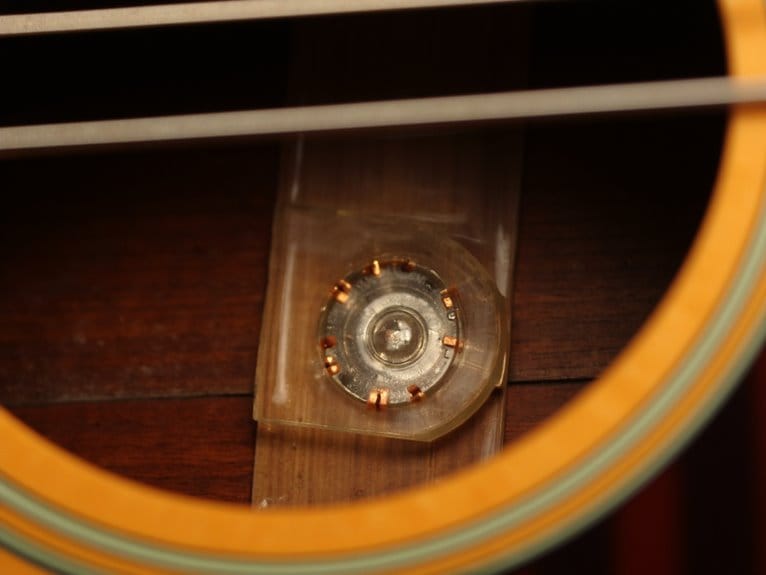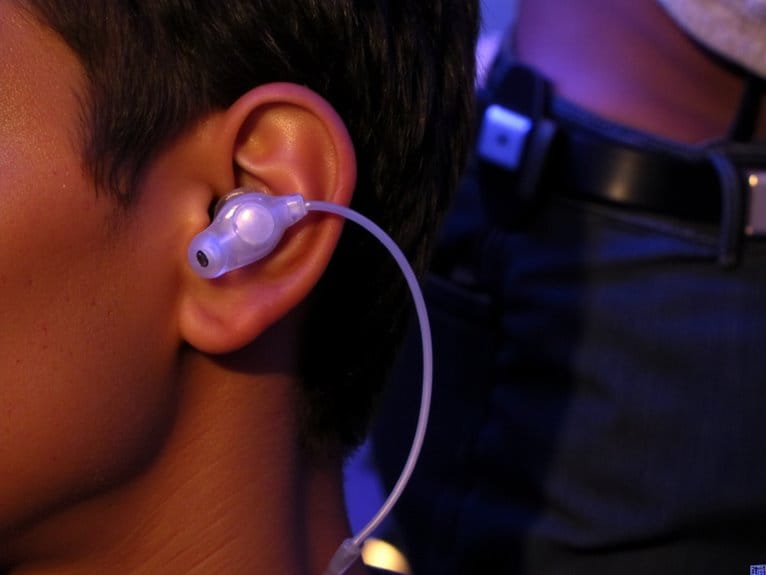What Is a Microphone and How Does It Work
A microphone converts sound waves into electrical signals through transduction, using essential components like a diaphragm that vibrates with acoustic energy, a voice coil that generates current through electromagnetic induction, and magnets that create stable magnetic fields for signal generation. You’ll find two primary types: dynamic microphones that utilize electromagnetic induction for loud sources without requiring power, and condenser microphones that rely on capacitors and phantom power for studio sensitivity. Understanding these fundamentals opens the door to optimizing performance across countless applications.
We are supported by our audience. When you purchase through links on our site, we may earn an affiliate commission, at no extra cost for you. Learn more.
Notable Insights
- Microphones convert sound waves into electrical signals through a process called transduction, making them essential for recording and amplification.
- The diaphragm vibrates with sound waves, while a voice coil moves within a magnetic field to generate electrical current.
- Dynamic microphones use electromagnetic induction and don’t need power, while condenser microphones use capacitors and require phantom power.
- Polar patterns determine sound capture direction: cardioid focuses forward, omnidirectional captures all directions, figure-of-eight records front and back.
- Key components include the diaphragm, voice coil, magnet, and capsule, which work together to convert acoustic energy into electrical signals.
Understanding the Purpose and Function of Microphones
When you think about how we capture and share sound in our modern world, microphones serve as the invisible bridge between acoustic waves and the electrical signals that power everything from your smartphone calls to stadium concerts.
Understanding microphone usage starts with recognizing their fundamental purpose: converting sound waves into electrical signals through a process called transduction, where a diaphragm responds to acoustic pressure changes and generates corresponding electrical output.
You’ll find microphones everywhere, from the tiny units in your earbuds to professional condenser models in recording studios, each designed to optimize audio quality for specific applications. Professional condenser microphones like the Audio-Technica AT2020 require phantom power to operate their sensitive capsules and deliver superior frequency response for studio recordings. The cardioid pattern effectively minimizes background noise by focusing on sound from the front while rejecting audio from the sides and rear.
Whether you’re recording vocals, amplifying live performances, or enabling voice recognition systems, microphones transform mechanical sound energy into electrical signals that can be recorded, transmitted, and amplified across countless devices and platforms. Dynamic microphones excel in loud environments due to their robust construction and ability to handle high sound pressure levels without distortion. Modern applications also include specialized uses such as ultrasonic sensors in automotive systems and knock detection technology.
Essential Components That Make Microphones Work
The intricate machinery inside every microphone relies on five essential components working together in perfect harmony, and I’ll walk you through each one so you can understand how these acoustic workhorses actually capture sound.
Here’s what makes your microphone tick:
- Diaphragm – This thin membrane, crafted from various diaphragm materials like plastic or aluminum, vibrates when sound waves hit it, translating acoustic energy into mechanical motion that mirrors incoming audio waveforms.
- Voice Coil – The coil construction involves wire wound around a core, moving with the diaphragm within a magnetic field to generate electrical current through electromagnetic induction.
- Magnet – Creates the stable magnetic field necessary for signal generation. Understanding this magnetic field mechanism helps explain why proper microphone positioning and environmental considerations are crucial for optimal recording quality.
- Capsule – Houses and protects all internal components from environmental damage. The capsule also enhances sound capture quality by reducing unwanted noise that could interfere with recording clarity. Quality capsules can achieve impressive specifications, with some models delivering a 78 dB signal-to-noise ratio for professional audio applications.
- Capacitor or Backplate – In condenser microphones, the diaphragm and backplate work together to form a capacitor system that converts sound into electrical signals through changes in capacitance.
The Science Behind Sound Wave Conversion
Although you can’t see them, sound waves constantly bombard your microphone’s diaphragm as invisible pressure variations that compress and expand the air molecules around it.
When these mechanical waves strike the diaphragm, they create proportional vibrations that correspond directly to the sound’s frequency and amplitude characteristics. Your microphone’s transducer then converts these physical movements into electrical voltage signals, preserving the original waveform’s shape and temporal patterns with remarkable fidelity.
The coil and magnet interaction within the microphone’s structure generates the electrical output that captures these acoustic details with precision. While conventional microphones detect mechanical displacement through various methods like capacitor plates or magnetic coils, cutting-edge quantum microphones are pushing boundaries by enabling phonon detection at the atomic level, measuring individual energy packets that constitute sound waves and opening possibilities for unprecedented sensitivity in audio capture. These electronic signals can then be amplified and converted back into sound waves through speakers, completing the audio reproduction cycle.
Dynamic Microphones: Electromagnetic Induction in Action
When you’re using a dynamic microphone, you’re witnessing electromagnetic induction at work, where sound waves create mechanical movement that generates electrical signals through the interaction between a moving coil and permanent magnet.
I’ve found that understanding how the voice coil cuts through magnetic field lines, producing voltage proportional to its velocity, helps explain why these mics capture sound with such reliable consistency across different environments.
You’ll discover that this elegant conversion process, transforming acoustic energy into electrical current through Faraday’s fundamental principles, forms the backbone of countless recording sessions, live performances, and broadcast applications worldwide. The microphone requires a lightweight assembly to achieve high fidelity reproduction by responding accurately to even the most subtle acoustic changes in the sound environment. These dynamic microphones are particularly valued for their ability to handle high sound pressure levels effectively, making them ideal for capturing loud instruments and vocals without distortion. Unlike condenser microphones, dynamic microphones don’t require phantom power since they generate their signal through electromagnetic induction rather than needing external electrical energy. Their excellent ability to reject background noise makes them especially suitable for untreated rooms and challenging acoustic environments.
Electromagnetic Induction Basics
Since sound waves carry energy that needs converting into electrical signals, dynamic microphones rely on electromagnetic induction to transform acoustic vibrations into usable audio output.
Understanding these induction principles helps you appreciate how your microphone actually works, because when the diaphragm vibrates from sound pressure, it creates coil movement within a magnetic field that generates electrical voltage.
Here’s how electromagnetic induction creates your audio signal:
- Magnetic flux changes – As the voice coil moves, it alters magnetic field lines passing through the conductor.
- Voltage generation – Faraday’s law dictates that changing magnetic flux induces electrical current in the coil.
- Signal proportionality – Induced voltage magnitude directly corresponds to diaphragm movement amplitude.
- Frequency matching – The electrical signal’s frequency mirrors the original acoustic wave’s frequency precisely.
The microphone’s performance depends on relative movement between the coil and magnet, which is why consistent diaphragm motion is essential for clear audio capture. Dynamic microphones excel in live performances because their electromagnetic design provides excellent resistance to background noise and handling interference.
Coil and Magnet Interaction
While the theoretical foundation of electromagnetic induction provides the scientific backdrop, the real magic happens when you examine how the voice coil and permanent magnet work together inside your dynamic microphone’s capsule.
The permanent magnet creates a consistent magnetic field, while the lightweight coil, typically aluminum alloy, sits within this field attached to your diaphragm. When sound waves hit the diaphragm, the coil dynamics change as it moves through the magnetic field, altering magnetic flux and generating electrical current.
The magnet strength directly affects your microphone’s sensitivity and output level—stronger magnets produce more efficient signal conversion. This mechanical-to-electrical transformation happens thousands of times per second, creating the electrical signal that mirrors your original sound wave’s amplitude and frequency characteristics.
Sound to Signal Conversion
The magic wand of audio engineering doesn’t require spells or incantations—it’s the dynamic microphone‘s electromagnetic induction process that transforms your voice into electrical signals with remarkable precision.
When you speak into a dynamic microphone, the sound wave impacts the diaphragm, which moves the attached voice coil through the magnetic field, generating an audio signal that mirrors your vocal characteristics.
Here’s how this conversion unfolds:
- Sound wave reception – Your voice creates pressure variations that strike the diaphragm
- Mechanical translation – The diaphragm’s movement drives the voice coil through magnetic flux lines
- Electrical induction – Coil motion generates current that represents the original audio signal
- Signal transmission – The resulting electrical output travels to amplification equipment for processing
Different Types of Microphones and Their Characteristics
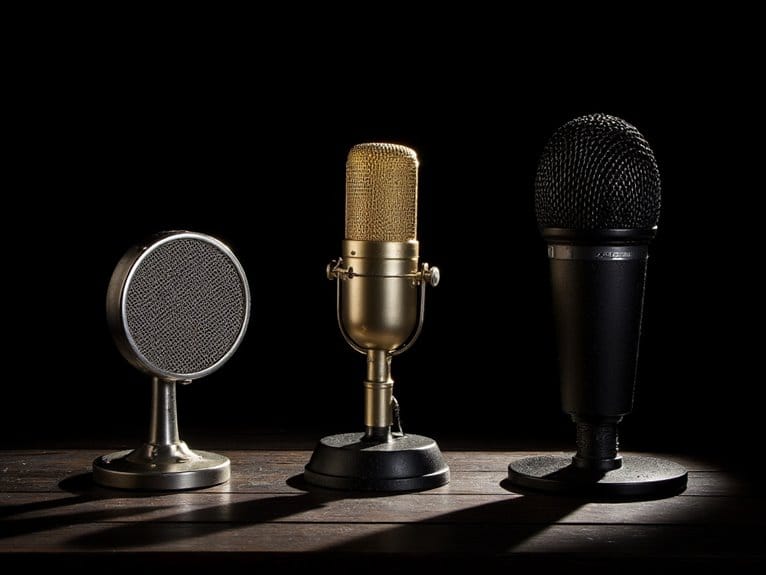
When you’re choosing a microphone, you’ll encounter two primary technologies that dominate today’s market: dynamic microphones, which use electromagnetic induction through a moving coil system, and condenser microphones, which rely on capacitor-based signal generation that requires phantom power from your audio interface or mixer.
Beyond the internal mechanics, you’ll also need to take into account how each microphone captures sound from different directions, since polar patterns like cardioid, omnidirectional, and figure-8 dramatically affect which sounds get picked up and which get rejected in your recording environment.
I’ve found that understanding these fundamental differences between dynamic versus condenser types, along with their directional characteristics, will save you countless hours of frustration and help you make informed decisions based on your specific recording needs.
Dynamic microphones like the Shure SM58 are particularly valued for their durability and effective background noise rejection, making them ideal for live vocals and environments where robust construction is essential. While dynamic microphones excel in live performances, condenser microphones are generally preferred for nuanced guitar tones in studio settings due to their superior frequency range depth and sensitivity.
Dynamic Vs Condenser Types
Understanding the fundamental differences between dynamic and condenser microphones is essential for making informed decisions about your audio equipment, as these two primary microphone types operate on completely different principles and serve distinct purposes in recording and live sound applications.
When exploring microphone comparisons, you’ll discover these audio technologies differ greatly in their construction and performance characteristics:
- Operating Principles – Dynamic mics use electromagnetic induction while condensers rely on capacitor elements requiring phantom power.
- Durability – Dynamics handle rough treatment and high SPLs, whereas condensers are more delicate but offer superior sensitivity.
- Sound Quality – Dynamics provide focused, robust audio for loud sources; condensers deliver detailed, nuanced capture with wider frequency response.
- Applications – Dynamics excel in live performances and broadcasting; condensers dominate studio recording environments.
Directional Pickup Patterns
While dynamic and condenser microphones represent the fundamental construction differences in audio capture technology, directional pickup patterns determine how these microphones actually “hear” sound from various angles around them, making this characteristic potentially more critical for selecting the right mic for your specific recording situation.
Omnidirectional microphones capture sound equally from all directions, which you’ll find useful for recording room ambiance or multiple speakers simultaneously, though they’ll pick up unwanted background noise.
Unidirectional microphones focus on sound from one primary direction, typically the front, offering superior source isolation but requiring more precise positioning.
Bidirectional patterns capture sound from front and back while rejecting sides, making them ideal for interviews or two-person recordings where controlled directional sensitivity matters most.
Frequency Response and Sensitivity Considerations
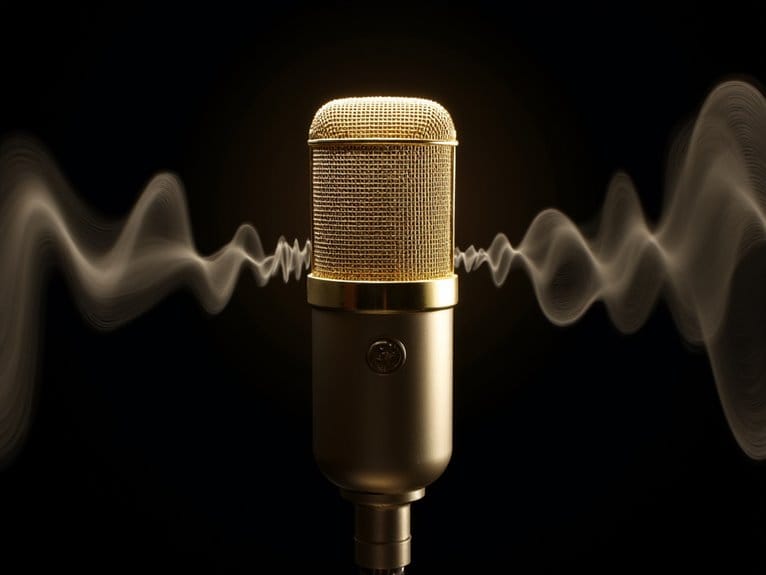
Across all these industrial and consumer applications, the performance differences between microphones often come down to two fundamental characteristics that determine how faithfully they’ll capture sound in your specific environment.
Frequency response types define how your microphone handles different sound frequencies from 20 Hz to 20 kHz. Flat response microphones capture all frequencies equally, while shaped responses emphasize or reduce specific ranges. Microphone sensitivity determines how effectively your device converts sound pressure into electrical signals, measured in decibels or volts per pascal.
| Response Type | Best For | Frequency Handling |
|---|---|---|
| Flat | Studio recording | Equal across range |
| Shaped peaks | Vocal enhancement | Boosted mid-frequencies |
| High-frequency roll-off | Noise reduction | Attenuated highs |
| Low-frequency roll-off | Speech clarity | Reduced bass |
| Customizable | Multi-purpose | Adjustable curves |
Understanding these specifications helps you match microphones to your intended applications effectively. For optimal audio quality in professional streaming setups, prioritize devices with at least 24-bit/192kHz resolution to capture detailed sound across the entire frequency spectrum. Quality USB condenser microphones utilize cardioid pickup patterns to focus on sound sources directly in front while rejecting ambient noise from the sides and rear.
Directional Patterns and Pickup Characteristics
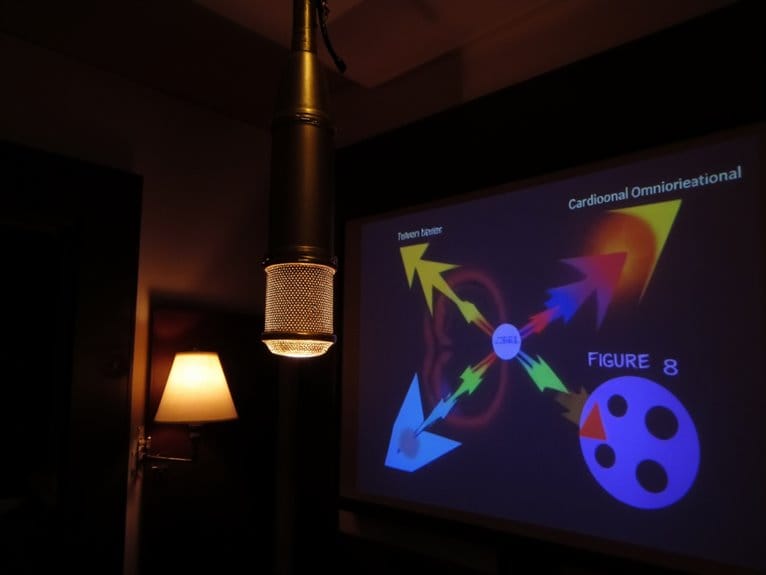
Beyond frequency response and sensitivity, every microphone’s directional pattern fundamentally determines which sounds it’ll capture and which it’ll ignore, making this characteristic debatably the most critical factor in achieving professional-quality recordings.
Understanding pickup pattern variations empowers you to choose the right tool for specific recording scenarios, whether you’re capturing intimate vocals or ambient soundscapes in challenging acoustic environments.
Here are the essential directional patterns you’ll encounter:
- Omnidirectional – Captures sound equally from all directions, ideal for natural room acoustics.
- Cardioid – Focuses primarily on front-facing sources while rejecting rear sounds.
- Figure-of-eight – Records from front and back while eliminating side interference.
- Lobar – Provides narrow, highly-focused pickup for distant sound sources.
Mastering sound isolation techniques through proper pattern selection dramatically improves your recordings by minimizing unwanted background noise, reducing feedback in live situations, and enhancing overall clarity.
Frequently Asked Questions
Can Microphones Work Without Electricity or Batteries?
You’ll find that dynamic microphones can work without electricity or batteries since they generate power from sound waves themselves, though I’ll admit the signal’s pretty weak without amplification.
Condenser microphones, however, absolutely need phantom power or batteries to operate their internal electronics.
While some newer wireless systems use energy harvesting from ambient signals, most microphones still require some form of external power for practical use.
Why Do Some Microphones Cost Thousands While Others Cost Under Twenty Dollars?
When you’re doing a microphone features price comparison, you’ll find that expensive mics use premium materials, advanced capsule technology, and superior build quality that I’ve tested extensively in professional settings.
Cheap mics cut corners with basic components, limited frequency response, and plastic construction, while thousand-dollar models offer hand-selected capsules, precision engineering, and consistent performance that honestly makes a noticeable difference in recordings.
What Happens if I Accidentally Drop Water on My Microphone?
If you’ve accidentally spilled water on your microphone, you’ll want to immediately turn it off and disconnect any power sources to prevent potential water damage from causing short circuits or corrosion.
Proper microphone care involves gently shaking out excess moisture, then allowing the unit to air dry completely for 24-48 hours before testing, since rushing this process can permanently damage sensitive internal components.
Do Wireless Microphones Have Delay Compared to Wired Microphones?
Yes, you’ll experience wireless latency with wireless microphones compared to wired ones, though modern systems have dramatically minimized this delay.
While wired mics deliver near-instantaneous audio transmission, wireless systems typically introduce 0.24ms to 19ms of delay depending on the brand and technology.
High-end models like Sony’s UWP-D maintain sub-millisecond latency that won’t affect sound quality or performance in most applications.
Can Using the Wrong Microphone Damage My Recording Equipment or Amplifier?
Using the wrong microphone won’t directly damage your recording equipment, though microphone compatibility matters considerably for equipment protection.
I’ve learned that excessive mic output can overload preamp inputs, potentially damaging budget mixers’ circuitry, while most mics themselves recover immediately from overloads.
You’ll want to use input pads or attenuators when dealing with loud sources, ensuring proper gain staging protects your entire recording chain.
On a final note
You’ve now got the essential knowledge to understand how microphones transform sound waves into electrical signals through various transduction methods. Whether you’re choosing a dynamic mic for live performance, a condenser for studio recording, or a lavalier for presentations, you’ll make informed decisions based on frequency response, polar patterns, and sensitivity requirements. Remember, proper positioning and handling techniques will maximize your microphone’s performance potential.

